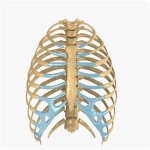Your Questions
Your Questions
Q: Dr. Eppley, I am very interested in the rib cage narrowing surgery to achieve a thinner waistline. I am a very slender individual with a wide ribcage, so unfortunately diet and exercise alone have not been able to give me my desired silhouette. I have experimented in corsetry and own a few but the discomfort, inconvenience, and lack of real results have left me desiring something more extreme. I’m not sure which ribs I need removed but by my count it would be the 10th 9th and 8th ribs. As you can see from my pictures I do have a quite bulky rib cage so I believe narrowing anywhere above the floating ribs on its straight line would give me the desired results.
 A: Ribcage narrowing, also called waistline narrowing, would be fair to be called a bit of an extreme approach. While there is a small scar on each side to access the ribs for removal, it can be a very effective procedure. It can certainly be uncomfortably initially as taking bony ribs is not without some discomfort from removing the attached intercostal muscles. Usually no more than two ribs are taken in any one location as the ribs do serve a purpose, they provide protection to what lies underneath. In addition you usually do not remove above rib #9 to stay below the level of the pleura/apices of the lungs.
A: Ribcage narrowing, also called waistline narrowing, would be fair to be called a bit of an extreme approach. While there is a small scar on each side to access the ribs for removal, it can be a very effective procedure. It can certainly be uncomfortably initially as taking bony ribs is not without some discomfort from removing the attached intercostal muscles. Usually no more than two ribs are taken in any one location as the ribs do serve a purpose, they provide protection to what lies underneath. In addition you usually do not remove above rib #9 to stay below the level of the pleura/apices of the lungs.
Dr. Barry Eppley
Indianapolis, Indiana
Q: Dr. Eppley, I was reading an article by a male to female transgender woman who mentioned having a procedure in Mexico where the doctor broke her lower ribs and wrapped them tightly so that they would fuse together in a more narrow position. I am a slim young woman who would like a more narrow rib cage to give me a longer more narrow waist, but would like to keep my ribs if at all possible. I assume this would be called “rib manipulation” since it is the controlled breaking of the lower ribs. Have you heard of this being done for cosmetic purposes and can you give me information on the pros and cons of this procedure?
 A: What you are referring to would be known as rib reshaping by osteotomies as opposed to the more traditional rib removal procedure to make a more narrow rib cage. The rib as it extends from the spine and around the side of the body is composed of bone (from the spine out to about halfway around the side of the body) and then becomes softer cartilage as it extends to join the sternum. (ribs 10 through 12, also known as the ‘free floaters’ do not extend to the sternum…which turns out to be a very important point in this discussion) If the rib is osteotomized (cut) at the bone-cartilage junction, the cartilaginous end would be more bendable and theoretically could be molded inward as it heals for a more narrow waistline with after surgery binding. This would only apply to the free floating ribs which do not have an attached end. It would not work for any higher ribs because they have a complete arc around the body with a fixed point to the sternum.
A: What you are referring to would be known as rib reshaping by osteotomies as opposed to the more traditional rib removal procedure to make a more narrow rib cage. The rib as it extends from the spine and around the side of the body is composed of bone (from the spine out to about halfway around the side of the body) and then becomes softer cartilage as it extends to join the sternum. (ribs 10 through 12, also known as the ‘free floaters’ do not extend to the sternum…which turns out to be a very important point in this discussion) If the rib is osteotomized (cut) at the bone-cartilage junction, the cartilaginous end would be more bendable and theoretically could be molded inward as it heals for a more narrow waistline with after surgery binding. This would only apply to the free floating ribs which do not have an attached end. It would not work for any higher ribs because they have a complete arc around the body with a fixed point to the sternum.
The advantages to rib reshaping is that it would be less invasive since the ribs are not being removed, would have an easier recovery, may be able to be be done with a smaller incision on each side and would preserve the ribs. The disadvantages is that it is not really clear if it would really work and could be a source of chronic pain if the separated rib area do not heal. (osteochondritis)
Dr. Barry Eppley
Indianapolis, Indiana
Q: Dr. Eppley, Is there a way I can find out more about the rib cage narrowing you have posted on your website? I am interested in this procedure and would like to know more about how it is done, costs involved, and recovery time. Thank you.
A: Ribcage narrowing, also called waistline narrowing surgery, is done by removing the 9th and 10th cartilaginous ribs (and occasionally the 8th) to make the waistline vertically longer and narrower from the sides by removing the bulges of the ribs. It is a procedure that may be effective for some patients based on their anatomy and if they are already fairly thin. It is done through a 4 to 5cm incision directly under the rib cage on each side. One has to carefully balance whether the thin scars are a good trade-off for the result. Recovery is solely based on the level of discomfort and is, of course, quite similar to traditional rib graft harvesting for rhinoplasty or mandibular reconstruction with the exception that it is done on both sides. Immediate pain management is aided by the use of rib nerve blocks and infiltration of long-acting local anesthetics into the rib and abdominal musculature. It is done under general anesthesia as an outpatient. The total cost of the procedure is around $6500 – $7500.
Dr. Barry Eppley
Indianapolis, Indiana
Q: Dr. Eppley, I am interested to find out about a surgery known as ribcage reduction or waistline narrowing. The lower part of my ribs stick out and makes my body look funny. I would like that area to be more narrow or go in. I have heard that some of the ribs can be removed which will make for more of a tapered look. How is this surgery done and what is the recovery like?
A: Rib removal is a real operation that can be done. It specifically refers to removal of any of the ribs on the lower end of the rib cage, from 8th to the 12 th ribs. All of these ribs are largely made of cartilage with some bone on the back end of them. Usually only the cartilage portion is removed. Which cartilaginous ribs are removed is matter of what one is trying to achieve. This is not, however, a waistline narrowing procedure since the ribs do not go down that low. This is to achieve a more narrow upper trunk/abdominal region around the ribcage area. This operation is, however, fairly ‘radical’ since it will leave a small scar and is associated with a fair amount of pain afterward. Realistically it would take four to six weeks to have most of the discomfort subside.
Dr. Barry Eppley
Indianapolis, Indiana

